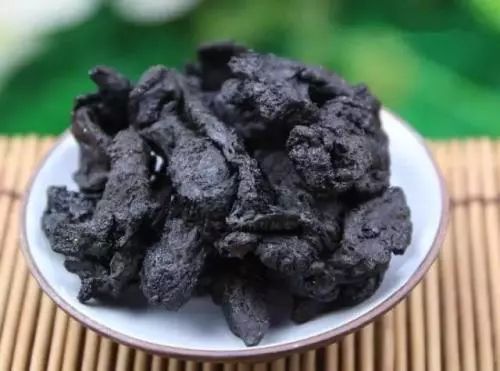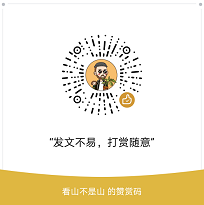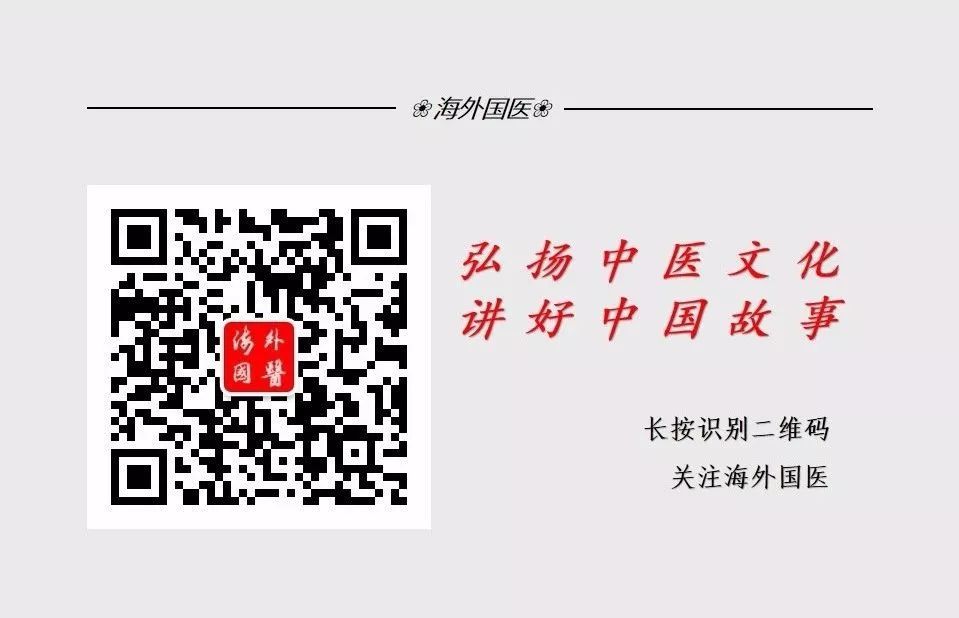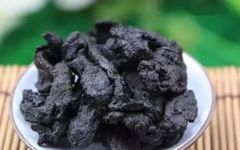Source: Bencao Fang

Shudi Huang (熟地黄) has been used in medicine since ancient times. The “Shennong’s Herbal Classic” states: “Long-term consumption can lighten the body and prevent aging.” At that time, there was no distinction between raw and cooked forms.
The processing method of Shudi Huang began in the late Han dynasty and was well established by the Tang and Song dynasties, where cooked Shudi Huang replaced the previously used dried Shudi Huang in kidney tonifying formulas.
During the Jin and Yuan dynasties, formula books clearly pointed out that the functions of cooked Shudi Huang differ from those of raw Shudi Huang, particularly in its kidney tonifying effects. For instance, Li Gao stated, “Shudi Huang, when steamed with fire, can replenish the original qi of the kidneys;” Zhang Zihe noted, “Cooked Shudi Huang nourishes the kidneys, and those with blood deficiency must use it.”
The most detailed understanding and application of Shudi Huang came from the Ming dynasty physician Zhang Jingyue. In his work “Complete Works of Jingyue,” he discussed Shudi Huang: “When cooked, its nature is neutral, embodying the virtue of extreme yin, with a pure and tranquil flavor, thus it can nourish the true yin of the five organs.”
“For those with yin deficiency and scattered spirit, it is not enough to rely on Shudi Huang to gather it; for those with yin deficiency and rising fire, it is not enough to rely on Shudi Huang’s heaviness to descend it; for those with yin deficiency and restlessness, it is not enough to rely on Shudi Huang’s tranquility to calm it; for those with yin deficiency and rigidity, it is not enough to rely on Shudi Huang’s sweetness to soften it; for those with yin deficiency and rampant water evils, without Shudi Huang, how can one control it? For those with yin deficiency and loss of true qi, without Shudi Huang, how can one return to the source? For those with yin deficiency and both essence and blood depleted, with thin and sparse fat, without Shudi Huang, how can one nourish the stomach?”
Thus, in his “New Eight Formulas: Supplementary Notes,” Shudi Huang is used in twenty-two of the twenty-nine formulas, often in large doses, commonly up to one or two taels, or even two to three taels. The Zhenyuan Decoction uses Shudi Huang as the main herb to greatly replenish the original qi of the kidneys, treating symptoms such as “shortness of breath resembling asthma, rapid breathing, inability to rise, inability to swallow, obstruction of the airways, and urgent and critical conditions.”
Moreover, the Jinshui Liujun Decoction pioneered the treatment of kidney tonification and phlegm transformation, addressing the syndrome of excess above and deficiency below.
By the Qing dynasty, the kidney tonifying and qi-nourishing effects of Shudi Huang were further recognized by many physicians. For example, in the “Continuing Cases of Famous Physicians,” there are cases of using large doses of Shudi Huang combined with ginseng, ophiopogon, achyranthes, schisandra, and poria to treat deficiency asthma. At that time, the great physician Zhang Xichun also had success using a decoction of Shudi Huang alone to treat labor-induced asthma within a few days. However, many physicians pointed out that Shudi Huang is rich and cloying, which can obstruct the stomach, and those with phlegm-dampness should avoid it. As stated in the “Bencao Mengquan”: “In blood tonifying formulas, do not exceed Shudi Huang and Angelica. If taken excessively, its nature can be obstructive, and it may also deplete the stomach qi.”
The “Bencao Shuyuan” quotes Miao Zhongchun saying: “For those with excessive phlegm in the chest and diaphragm, obstructed qi pathways, and suffocation during ascent and descent, Shudi Huang should not be used in decoctions that promote circulation. Clinically, many have been influenced by this and are wary of using Shudi Huang, especially those who prefer lighter medications, viewing heavy use of Shudi Huang as excessive and foolish, scoffing at it. The efficacy of Shudi Huang is not universally agreed upon.
My grandfather practiced medicine and left behind a formula for treating phlegm and asthma, consisting of only five ingredients: Shudi Huang, Bai Shao (White Peony), Gan Cao (Licorice), Lai Fu Zi (Radish Seed), and Bai Guo (Ginkgo Nut). According to my father’s recollection, it was very effective. When I first started studying medicine, I was quite puzzled; Shudi Huang is thick and cloying, which aids dampness, so how could it be used to treat phlegm and asthma? Therefore, I did not dare to try it lightly in clinical practice for many years.
Later, after reading Mr. Qiu Peiran’s article “Hutian Sanmo: This Matter is Most Difficult to Know – Also Discussing Zhang Shudi,” which presented a case of a patient with “severe phlegm asthma, chest tightness, abdominal distension, reduced appetite, frequent coughing, … qi reversal and urgent asthma, a haggard appearance, and a weak spirit, with a thick white coating on the tongue, having used various formulas to promote yang, move the spleen, regulate qi, and eliminate phlegm for half a year without effect, later another physician prescribed Jinshui Liujun Decoction, heavily using Shudi Huang (45 grams) and Angelica (30 grams), and after three doses, it was effective, recovering in half a month.” I then realized that Shudi Huang can indeed treat asthma, and there is evidence to support it.
Upon reading Mr. Wang Xugao’s medical case, I felt enlightened. Mr. Wang treated chronic phlegm asthma with kidney deficiency, regardless of whether there was phlegm-dampness, he would use Shudi Huang or formulas like Liuwei Dihuang (Six Flavor Rehmannia) to nourish qi and tonify the kidneys, either using it alone or in combination with methods to clear phlegm and transform it, even if “the tongue coating is yellow and turbid,” Shudi Huang was not avoided, and large doses were used, believing that “for those with significant liver and kidney deficiency, the focus should be on nourishing and gathering,” as Shudi Huang is best at eliminating phlegm due to deficiency, as it can fill and transform kidney qi into formless phlegm,” and he advised future practitioners: “Do not fear its cloying nature and avoid it.” Since then, I have come to understand that Shudi Huang’s functions not only nourish yin and blood, tonify the kidneys, and strengthen essence, but also gather qi and return to the source, eliminating phlegm due to deficiency. After clinical verification, I unexpectedly achieved excellent results.
Years of practical experience have led me to believe: Shudi Huang, with its thick and heavy flavor, contains yin within yang, is an excellent medicine for treating deficiency asthma and mixed syndromes of deficiency and excess. Although there are many substances that can gather qi, none surpass this, as long as it is skillfully combined, it can yield remarkable effects. In specific applications, I have the following insights:
1. Shudi Huang is used to treat deficiency asthma, characterized by shortness of breath and insufficient inhalation, with exacerbation upon movement. As long as these symptoms are present, regardless of tongue and pulse conditions, whether phlegm is present or not, it can be used without hesitation.
2. To use Shudi Huang for kidney tonification and qi-gathering, the dosage must be large, generally 30-45 grams, and up to 60 grams; a small amount is ineffective, only a large dose can achieve focused and powerful effects.
3. Pay attention to compatibility. Chronic cough and asthma patients may have more deficiency than excess, a balance of deficiency and excess, or differing cold and heat conditions. Clinically, careful differentiation and treatment are necessary. If cough and asthma occur intermittently, primarily deficient, treat with kidney tonification and foundational support, using Shudi Huang, Shan Yao (Chinese Yam), Bai Zhu (White Atractylodes), Dang Shen (Codonopsis), Mai Dong (Ophiopogon), Fu Ling (Poria), Wu Wei Zi (Schisandra), and Hu Tao Ren (Walnut). For those with internal cold and yang deficiency, add Lu Jiao Jiao (Deer Antler Glue), Xian Ling Pi (Epimedium), Du Zhong (Eucommia), and Tu Si Zi (Cuscuta). For those with yin deficiency and internal heat, remove Dang Shen, and add Hu Tao Ren, Zhi Mu (Anemarrhena), and Sheng Di (Raw Rehmannia), or use Mai Wei Di Huang Decoction with Ejiao (Donkey-hide Gelatin) and Niu Xi (Achyranthes). For frequent cough and asthma, with no end in sight, if the condition is due to yang deficiency with fluid retention, treat with Yang He Decoction; if it is yin deficiency with phlegm, treat with Jinshui Liujun Decoction.
For acute onset due to external pathogens, with cough and asthma, rapid breathing, and phlegm that is yellow or white and sticky, with a red tongue and dry mouth, it is advisable to use methods to clear the upper and consolidate the lower, using Shudi Huang, Shan Yao, Yun Ling, Mai Dong, Wu Wei, Hu Zhang, Zao Ti, Yu Xing Cao, Zhu Li Shui, Chao Qin, and Dan Xing. If there is obstruction in the bowels, add Da Huang (Rhubarb); if there is qi deficiency and risk of collapse, add Ren Shen (Ginseng); if there is blood stasis, consider using Dan Shen (Salvia) and Tao Ren (Peach Kernel) to invigorate blood and resolve stasis.
In summary, based on the differences in deficiency and excess, cold and heat, and severity, treatment should be adjusted accordingly, while the principle of gathering qi and tonifying the kidneys remains unchanged. This is also the meaning of supporting the righteous to dispel the evil. Clinically, I have encountered cases of chronic bronchitis and emphysema combined with acute infection, where using only antibiotics and herbal medicines to clear the lungs and transform phlegm showed no significant effect, and the condition lingered. However, after switching to a method of gathering qi and tonifying the kidneys while also dispelling evil and transforming phlegm, the infection was controlled, and the condition improved rapidly, with Shudi Huang playing an indispensable role.
4. Understanding the role of Shudi Huang in eliminating phlegm due to deficiency. As mentioned in Mr. Wang Xugao’s case, the discussion on phlegm asthma follows the theory of phlegm due to deficiency, which is characterized by kidney deficiency unable to control water, leading to phlegm rising. A typical sign is that the phlegm has a salty taste, which is its characteristic. Shudi Huang greatly tonifies kidney qi, allowing water and dampness to be vaporized, thus the phlegm dissolves and disappears, hence the term “eliminating phlegm due to deficiency.” Mr. Wang’s statement emphasizes this point, not implying that Shudi Huang has a direct phlegm-transforming effect, which should not be misunderstood.
5. Understanding the cloying nature of Shudi Huang. Shudi Huang is thick and cloying, which can obstruct the stomach and aid dampness, this is indeed the case, but it should not be generalized. Even ancient texts refer to this in specific situations such as stomach deficiency or excessive phlegm-dampness. For instance, the “Bencao Zhengyi” states: “If a person has a weak stomach and is already weak or has chronic illness, this can lead to fullness and hinder food intake, and even cause bloating, which can be quite harmful, especially if phlegm-dampness is present or combined with external pathogens.” In my clinical observations, I have found that for those with excessive dampness in the spleen and stomach, or qi stagnation due to deficiency, Shudi Huang can indeed cause qi stagnation and hinder movement, leading to increased abdominal distension and poor appetite after taking the medicine. However, for those with phlegm turbidity in the lungs and normal spleen and stomach function, this issue does not arise. Regarding “phlegm due to deficiency,” it is clear that without Shudi Huang, it cannot be eliminated. Furthermore, in clinical practice for patients with mixed deficiency and excess phlegm asthma, it is common to tonify the kidneys and transform phlegm simultaneously, and to moisten dryness together, thus the adverse effects of Shudi Huang obstructing the stomach and aiding dampness do not manifest.
Attached Medical Case:
Liu, male, 70 years old. Hospital ID: 01632. The patient has a history of chronic bronchitis and emphysema, and a history of surgery and radiotherapy for left lung squamous cell carcinoma. He was admitted on October 31, 1992, due to aggravated cough and asthma for half a month. Symptoms included paroxysmal cough, uneven breathing, wheezing, difficulty expectorating phlegm, dark red tongue with yellow greasy coating, and wiry rapid pulse. Physical examination revealed widespread phlegm sounds in both lungs. Chest X-ray upon admission showed:
1. Left lung cancer postoperative right lung hilar metastasis;
2. Chronic bronchitis and emphysema with infection. Treatment included cefradine, ampicillin, hormones, and theophylline for anti-infection, anti-inflammatory, and bronchodilation, while also taking herbal medicines to clear the lungs and transform phlegm. After two weeks, the patient’s condition improved somewhat, but he still experienced cough and asthma, with shortness of breath and difficulty inhaling, exacerbated by movement, with little sticky phlegm, and the tongue still showing yellow greasy coating, while also reporting dampness in the scrotum, heat intolerance, and excessive sweating, with acceptable appetite.
Upon auscultation, there were scattered dry and wet rales in both lungs. The patient appeared overweight, with a dark red face and dirt. The pulse and symptoms indicated the presence of phlegm-dampness, with phlegm-heat in the lungs above and damp-heat lingering below, and a constitution of excessive phlegm-dampness. However, due to the patient’s long history of cough and asthma, and the recurrence of cancer, the kidney essence was severely depleted, leading to kidney deficiency and inability to gather qi, resulting in shortness of breath and inability to resist pathogens, thus phlegm-dampness could not be transformed. The treatment should focus on tonifying the kidneys and consolidating the foundation while also clearing and transforming phlegm-dampness.
Following the method of Jinshui Liujun Decoction: Sheng Shudi (Raw Rehmannia) and Shu Di (Cooked Rehmannia) each 24 grams, Bai Shao (White Peony) 15 grams, Shan Yao (Chinese Yam) 30 grams, Ban Xia (Pinellia) 10 grams, Dan Xing (Bitter Herb) 10 grams, Hu Zhang (Polygonum) 15 grams, Ku Shen (Sophora) 10 grams, Che Qian Zi (Plantago Seed, wrapped for decoction) 10 grams, Wu Gong (Centipede) 6 pieces, Tao Ren (Peach Kernel) 10 grams, and Dang Gui (Angelica) 20 grams. 7 doses. After taking the medicine, the patient reported feeling comfortable, with reduced sensation of phlegm obstruction in the throat, easier expectoration, disappearance of scrotal dampness, and alleviation of cough and wheezing.
Observing the greasy coating, the original formula was adjusted: removing Sheng Di and Che Qian Zi, increasing Shudi to 45 grams, and adding Yun Ling (Poria) 12 grams and Chen Pi (Tangerine Peel) 6 grams. 7 doses. The patient’s cough stabilized and wheezing improved, but there was still shortness of breath upon exertion. Physical examination showed disappearance of rales in both lungs. The original formula was continued for consolidation. Subsequently, Jinshui Liujun Decoction was used as the base, with the addition of Dang Shen, She She Cao (Hedyotis), and Shi Shang Bai (Stone Pine) as supportive anti-cancer herbs, adjusted as needed. When phlegm was abundant, Dan Xing, Hu Zhang, Zao Ti, and Bai Jie Zi (White Mustard Seed) were added; when phlegm was less, Shan Yao, Bu Guo Zhi (Psoralea), and Gou Qi Zi (Goji Berry) were included. The patient’s condition stabilized and gradually improved, with shortness of breath disappearing. By April 1993, he was discharged in good general condition, with no wheezing during indoor activities, and was fully self-sufficient.
According to the patient, he felt significantly better compared to before admission when he did not experience cough and asthma. On October 8, 1994, the patient was readmitted after catching a cold, with a recurrence of cough and asthma, and was treated with the same method, with cough and asthma controlled, and he is still undergoing treatment.
This article is excerpted from the “Shanghai Journal of Traditional Chinese Medicine,” Issue 10, 1995.
Supplement:
Jinshui Liujun Decoction comes from the “Complete Works of Jingyue,” originally composed of: Dang Gui 2 qian, Shudi 3 to 5 qian, Chen Pi 1.5 qian, Ban Xia 2 qian, Fu Ling 4 qian, Zhi Gan Cao 1 qian, and Sheng Jiang 3 to 7 slices.
Jingyue states: This formula can “treat lung and kidney deficiency cold, water rising as phlegm, and elderly patients with yin deficiency, insufficient qi and blood, and external wind-cold, cough, nausea, excessive phlegm, and wheezing.” “For those with insufficient yin qi, excessive phlegm, and dryness leading to cough, Jinshui Liujun Decoction is indicated. For those with yin deficiency and blood deficiency, or spleen and lung deficiency cold, they are most susceptible to pathogens. However, if the pulse and body are slightly weak, with no obstruction in the chest and diaphragm, or kidney qi deficiency with water rising as phlegm, or heart discomfort with nausea, or if they are middle-aged with weak blood and qi leading to cough that cannot be cured, they should all be treated with Jinshui Liujun Decoction with adjustments. If the deficiency is in the yin aspect and water rises as phlegm leading to vomiting, Jinshui Liujun Decoction is also indicated.”
Reminder:Everyone’s physical condition is different; the formulas provided in this article should be adjusted according to individual conditions. It is recommended to seek guidance from a professional physician. (Images from the internet; please contact for removal if there is any infringement.)


Click here to read: Emergency Treatment for Stroke – I am so grateful I studied TCM; a sewing needle saved my father
A formula from the medical sage Zhang Zhongjing sweeps away palpitations, arrhythmias, premature beats, atrial fibrillation, and sudden cardiac arrest
After 1800 years, this classic formula finally has a Chinese patent medicine, with excellent effects!
Click “Read the original text“↙ to see more exciting content

